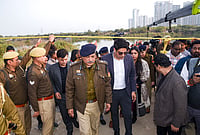The remains of 11 climbers were retrieved on Monday following a violent eruption of Mount Marapi in Indonesia. Rescue teams are actively searching for at least 12 individuals who are reported as missing.
Around 75 climbers started their ascent of the nearly 2,900-meter (9,480-foot) mountain on Saturday and became stranded. Among those rescued on Sunday, eight were promptly taken to hospitals for burn injuries, and one person had a broken limb, as told by Hari Agustian, an official at the local Search and Rescue Agency in Padang, the provincial capital.
All of the climbers had registered at two command posts or online through West Sumatra's conservation agency before they climbed, Agustian reportedly said. It was possible others took illegal roads or local residents were active in the area, but it couldn't be confirmed.
Mount Marapi, situated in the Agam district of West Sumatra province, unexpectedly spewed dense ash columns, reaching heights of 3,000 meters (9,800 feet) on Sunday. The eruption resulted in hot ash clouds spreading across several miles, covering villages and nearby towns with tons of volcanic debris.
Falling ash blanketed several villages and blocked sunlight, and authorities distributed masks and urged residents to wear eyeglasses to protect them from volcanic ash. About 1,400 people live on Marapi's slopes in Rubai and Gobah Cumantiang, the nearest villages about 5 to 6 kilometres from the peak.
Marapi has stayed at the third highest of four alert levels since 2011, a level indicating above normal volcanic activity and prohibiting climbers or villagers within 3 kilometres of the peak, said Hendra Gunawan, the head of the Centre for Volcanology and Geological Disaster Mitigation to AP.
“This means that there should be no climbing to the peak,” Gunawan said, adding that climbers were only allowed below the danger zone, "but sometimes many of them broke the rules to fulfil their satisfaction to climb further.”
Gunawan said that Sunday's eruption was not preceded by a significant increase in volcanic earthquakes. Deep volcanic earthquakes were only recorded three times between November 16 and on Sunday, while the deformation equipment or tiltmeter on the peak showed a horizontal pattern on the radial axis and a slight inflation on the tangential axis.
“This shows that the eruption process is taking place quickly and the centre of pressure is very shallow, around the peak,” he said.
Marapi has been observed regularly erupting since 2004 with a gap of 2 to 4 years, Gunawan said.
“Marapi eruptions are always sudden and difficult to detect using equipment because the source is near the surface,” Gunawan said, “This eruption was not caused by the movement of magma.”
Abdul Malik, the head of West Sumatra's Search and Rescue Agency, stated that on Monday morning, rescuers discovered the bodies of 11 climbers during their ongoing search for those still missing. He emphasized that the evacuation process for both bodies and survivors is still in progress, with rescuers actively seeking the 22 climbers reportedly still unaccounted for.


























